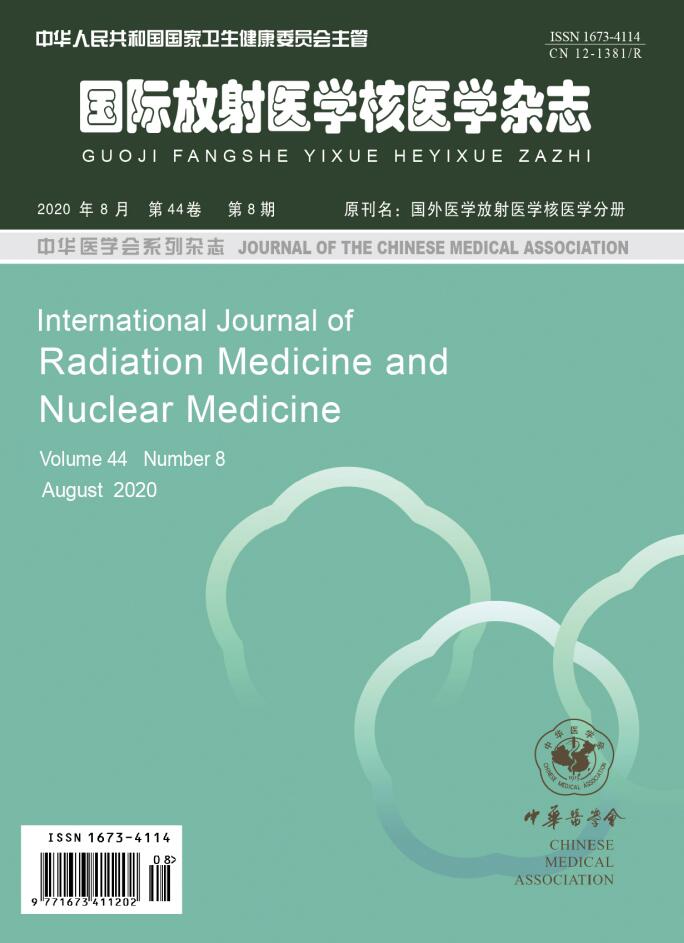-
甲状腺髓样癌(medullary thyroid carcinoma,MTC)占所有甲状腺恶性肿瘤的5%~10%[1-2],分为散发型和遗传型两类[3-4],恶性程度介于乳头状癌和未分化癌之间,属于中等恶性肿瘤,其复发率和早期转移率较高,预后相对较差[5-6]。可触及肿瘤的MTC患者,81%存在颈部淋巴结转移,15%出现声音嘶哑或吞咽困难等局部神经浸润的症状,10%发生远处转移[7]。MTC在世界范围内的10年生存率为65%~70%[8],其与病灶是否发生转移直接相关,因此早期诊断及治疗是取得较好疗效的前提。
-
研究结果显示,约20%~30%的遗传型MTC患者存在RET原癌基因突变,约4%~10%的散发型MTC患者也存在RET原癌基因突变。携带RET基因突变的患者其后代有50%的概率将遗传此突变,因此,当有患者发现RET基因突变时,其家庭成员也应该接受基因检测[6, 9-11]。2015年美国甲状腺协会(American Thyroid Association,ATA)指南指出,17种最常见的RET原癌基因突变不仅是MTC的危险因素,也是嗜铬细胞瘤和甲状旁腺功能亢进症的危险因素[10]。因此,RET原癌基因突变不一定都合并MTC。
-
1966年Williams[12]发现MTC起源于甲状腺滤泡旁细胞(也称C细胞)。1968年,Tashjian和Melvin[13]发现C细胞能产生降钙素。此后,降钙素作为临床上MTC最常用的肿瘤标志物,不仅被广泛应用于MTC的诊断及病情监测,而且还被用于MTC患者的危险分级及外科手术方式选择的指导,并可根据术前和术后降钙素水平的变化判断病灶是否完全切除[9]。但其在临床上缺乏特异性,因为降钙素水平升高还可见于C细胞增生、肾功能受损、自身免疫性甲状腺疾病、慢性高钙血症和高胃泌素血症等。MTC在进展期可出现癌胚抗原(carcinoembryonic antigen,CEA)水平升高,但CEA是多种肿瘤的生物学标志物,同样缺乏特异性。此外,降钙素和CEA与肿瘤负荷密切相关,应用其对MTC进行诊断易出现假阴性结果[14]。
Trimboli和Giovanella[15]的一项Meta分析结果显示,检测降钙素原(procalcitonin,pro-CT)用于MTC的诊断并不劣于降钙素,甚至在少数降钙素阴性的患者中,pro-CT的检测灵敏度更高,且检测费用较低。Trimboli等[16]对55例MTC患者的回顾性分析结果显示,术后复发的MTC患者的pro-CT和降钙素水平显著高于无复发的患者,因此推测pro-CT有望成为MTC诊断方法的另一灵敏指标,并建议将pro-CT作为降钙素的补充指标来跟踪MTC患者。
-
随着超声成像技术的不断进步,甲状腺疾病的诊断水平得到提高[17-18],超声检查现已成为甲状腺检查的首选方法,所有怀疑MTC的患者都应进行颈部超声检查。但超声检查对MTC的诊断缺乏特异性,MTC可见甲状腺乳头状癌的超声特征,甚至多达1/3的MTC具有“非恶性”超声表现[18]。
有广泛颈部病变、局部侵犯、远处转移及血清降钙素>500 pg/mL的患者,为了及时发现远处转移病灶,建议行颈、胸、腹部增强CT或MRI,中轴骨和骨盆骨SPECT或MRI,但不建议行18F-FDG PET/CT和18F-6-L-多巴(DOPA)PET/CT[10]。然而,一项Meta分析结果显示,在复发的MTC患者中,生长抑素受体PET/CT可以提高检出率[19]。Souteiro等[20]的最新研究结果显示,与18F-FDG PET/CT相比,68Ga-1,4,7,10-四氮杂环十二烷-1,4,7,10-四乙酸-1-萘丙氨酸-奥曲肽(DOTANOC)能检出更多病灶,且68Ga-1,4,7,10-四氮杂环十二烷-1,4,7,10-四乙酸-1-萘丙氨酸-奥曲肽(DOTANOC)阳性、18F-FDG阴性患者的降钙素倍增时间短。降钙素和CEA的倍增时间与患者的总生存率密切相关,反映了肿瘤的进展情况,被认为是总生存率的替代指标。多项研究结果显示,降钙素和CEA的倍增时间>2年时无MTC患者死亡报道,而倍增时间<6个月时患者的5年生存率仅为25%[21-23]。因此,68Ga-1,4,7,10-四氮杂环十二烷-1,4,7,10-四乙酸-1-萘丙氨酸-奥曲肽(DOTANOC)有望被应用于MTC的诊断及分期分级。
-
2015年ATA指南指出,长径≥1 cm的甲状腺结节应行FNAC[10]。然而,Trimboli等[24]的meta分析结果显示,FNAC对MTC诊断的准确率不到50%。当FNAC不能诊断或提示MTC时,则需要进一步检测FNAC冲洗液中的降钙素水平和对穿刺标本进行免疫组化染色[10]。
-
由于RET原癌基因的突变位点、碱基置换类型与疾病的表型密切相关,2015年ATA指南根据MTC的侵袭性将其划分为最高风险、高风险以及中等风险3个等级[10]。其中,最高风险包括M918T突变,高风险包括634位点上的所有突变以及A883F突变,中等风险包括除上述突变以外的其他基因突变。该指南推荐最高风险患儿应在1岁内行预防性手术,并且越早越好;高风险患儿应在5岁内行预防性手术,可根据血清降钙素水平适当提前;而中等风险患儿应在发现血清降钙素水平异常时行预防性手术[10]。Frank-Raue和Raue[25]的研究结果显示,在规定年龄进行手术治疗的MTC患者没有出现复发,而超年龄进行手术的患者的复发率为42%,在较短时间内进行手术切除的超年龄患者的无病生存期更长。因此,建议遗传型MTC患者接受适龄的甲状腺切除术,超过推荐年龄的患者应尽早进行手术以提高无病生存率。
-
目前MTC的治疗方案主要是“甲状腺全切除+预防性颈部中央区淋巴结清扫”,研究结果显示,颈部中央区淋巴结清扫可以提高患者的治愈率[5, 10, 26]。但Kuo等[27]的回顾性分析结果显示,初次行甲状腺切除术时,仅有35.5%(216/609)的患者接受了颈部中央区淋巴结清扫,再手术率为16.3%(99/609)。若B超显示侧颈区淋巴结转移时应加行侧颈区淋巴结清扫。如果存在广泛的区域或远处转移,为了保留讲话、吞咽、甲状旁腺功能和肩部活动功能,可行中央和一侧颈部创伤较小的姑息性手术。为了控制局部肿瘤病灶,应考虑行外照射放疗(external-beam radiation therapy,EBRT)、系统内科治疗和其他非手术治疗[10]。
-
由于MTC呈侵袭性生长,早期转移率高[3],因此,治疗残留、转移和复发性病灶对于患者的长期生存至关重要。其治疗方案包括观察和主动监测、手术治疗、EBRT、其他定向治疗(如射频消融、冷冻消融和栓塞)和系统性治疗(如化疗、分子靶向治疗和免疫治疗)[28]。这些患者的管理方法取决于各种临床因素,包括疾病是否可以定位、病灶大小、转移威胁的重要器官、存在的疾病相关症状或临床进展的可能性。
-
对于仅行甲状腺次全切或仅摘除病变组织的患者,若发现降钙素水平高于正常范围、B超显示肿瘤残留或基因检测证实为遗传型MTC的患者,应行补全性甲状腺切除和颈部中央区及同侧颈淋巴结清扫[29]。对于持续或反复局部病灶,包括影像学阳性的病灶,活检阳性的病灶,以及肺、肝、脑等部位大体积的孤立性转移病灶,应该考虑行手术切除,以防止其侵入周围的主要结构[10]。有研究结果表明,再次手术能够使1/3的患者的局部疾病得到控制,生化学指标归于正常[30]。
-
虽然EBRT用于MTC的治疗已超过40年,但关于其适应证的临床试验尚有限,目前不作为MTC的标准治疗方法[31]。1977年,Steinfeld[32]采用EBRT治疗4例MTC患者并实现了3~6年的疾病局部控制,但这4例患者均出现了远处转移,因此他建议采用EBRT治疗MTC局部复发病灶。Samaan等[33]的回顾性分析研究的结论则恰好相反,在57例接受了全切或次全切治疗的MTC患者中,将术后行EBRT的患者与仅接受手术治疗的患者进行比较,结果显示术后行EBRT的患者的生存率低于仅接受手术治疗的患者。Jensen等[34]的多中心回顾性分析中纳入了5287例患者,其中包括200例MTC患者,研究结果显示,手术治疗后再行EBRT的患者的5年生存率为100%,而仅接受手术治疗的患者的5年生存率为91%;同时也有研究结果发现,EBRT对局部复发患者较有效,而对远处转移患者无效[32]。目前,ATA建议将EBRT用于术后患者的辅助治疗、手术风险高的局部复发患者及伴远处转移患者的姑息治疗[10, 31]。
-
2015年ATA指南不推荐应用单药或联合的细胞毒性药物作为持续性或复发性MTC的化疗方案,原因是其治疗反应率低[10]。而靶向小分子激酶抑制剂的出现使MTC的治疗发生了医学革命性的变化。近年来,MTC靶向治疗的研究主要集中在受体多靶点酪氨酸激酶抑制剂(TKI)、放射性核素治疗和抗血管生成等方面。酪氨酸激酶抑制剂(TKI)可以选择性抑制RET原癌基因、血管内皮生长因子受体和内皮生长因子受体依赖的信号通路,减少血管生成,降低血管通透性,抑制肿瘤的生长和侵袭[31, 35]。酪氨酸激酶抑制剂(TKI)中凡德他尼和卡博替尼已经获得美国食品药品监督管理局批准用于MTC的治疗[31, 36]。对于晚期MTC患者,凡德他尼或卡博替尼可以作为一线的单药治疗,但其主要的局限性是存在药物相关的不良反应[37]。目前,新型靶向药已成为研究的热点。朱高红团队设计合成了新型探针131I-PAMAM(G5.0)-peptides(其中,PAMAM为聚酰胺-胺),并进行了体内外细胞实验,结果显示131I-PAMAM(G5.0)-SR(其中,SR为丝氨酸-精氨酸-谷氨酸-丝氨酸-脯氨酸-组氨酸-脯氨酸,即SRESPHP,简称SR)具有SR靶向人MTC细胞(TT细胞株)的特性以及131I介导的在MTC细胞水平上的治疗效果,并且其在模型鼠体内对肿瘤具有很好的靶向性和滞留性,有望应用于MTC的靶向诊治及预后评估;而131I-PAMAM(G5.0)-GP(其中,GP为甘氨酸-脯氨酸-亮氨酸-脯氨酸-亮氨酸-精氨酸,即GPLPLR,简称GP)靶向MTC肿瘤新生血管,使其在瘤体的摄取及代谢较快,有望应用于MTC SPECT显像,为MTC的精准靶向诊治及临床转化提供新的思路[38-40]。另外,由于核受体4A1在调节多种肿瘤细胞的增殖和凋亡中起着关键作用[41],也参与由哺乳动物雷帕霉素靶蛋白(mTOR)调节的细胞增殖信号通路[42],因此,有学者基于核受体4A1的蛋白质结构,从Specs化合物数据库中筛选出2-亚氨基-6-甲氧基-2H-色烯-3-硫代甲酰胺(IMCA),并进行相关实验,细胞凋亡实验测定结果表明,2-亚氨基-6-甲氧基-2H-色烯-3-硫代甲酰胺(IMCA)明显导致了甲状腺癌细胞的凋亡。2-亚氨基-6-甲氧基-2H-色烯-3-硫代甲酰胺(IMCA)是MTC治疗的候选药物,其还可以通过增加核受体4A1向细胞质和肿瘤蛋白53-雌激素-AMPK-mTOR(其中,AMPK为腺苷5’-单磷酸激活蛋白激酶)信号通路的核输出而起作用[43]。
-
行甲状腺全切除术患者应常规给予甲状腺素替代治疗。由于滤泡旁细胞肿瘤不依赖TSH,而且没有证据显示甲状腺激素疗法抑制TSH分泌后可减少MTC的复发或提高患者的生存率,因此,MTC患者行甲状腺全切除术后一般推荐将TSH控制在1~2 mU/L[10]。
-
MTC是一种不同于其他形式甲状腺癌的罕见恶性肿瘤,其具有潜在侵袭性及早期淋巴结转移性。早期诊断对于MTC的治疗及转归至关重要,然而MTC的术前诊断仍是当今世界的医学难题,作为“金标准”的FNAC也只能检测到大约50%的MTC病变,而且其对技术的要求较高。目前公认的MTC最有效的治疗方法仍是手术切除,对于手术无法切除的病灶可根据累及范围,选择恰当的进一步治疗方法,以提高患者的生活质量或生存率。对于局部复发而又无法手术切除的患者,常采用EBRT治疗。对于MTC晚期患者,凡德他尼和卡博替尼可以作为一线的单药治疗,但药物的不良反应明显。综上,目前仍需临床医师和科研人员共同努力,进行多中心、大样本量的靶向药物临床试验研究,为MTC的精准诊治寻求新的突破。
利益冲突 本研究由署名作者按以下贡献声明独立开展,不涉及任何利益冲突。
作者贡献声明 冯成涛负责综述的撰写;朱高红负责综述的审阅。
Recent advances in the diagnosis and treatment of medullary thyroid carcinoma
- Received Date: 2019-04-03
- Available Online: 2020-08-25
Abstract: Medullary thyroid carcinoma (MTC) is a type of neuroendocrine tumor that originates from calcitonin-producing parafollicular C cells of the thyroid. It is a moderate malignant thyroid carcinoma with a high recurrence rate and an early metastasis rate. The common diagnostic methods include detection of calcitonin, and tumor markers (such as carcinoembryonic antigen), ultrasound, fine needle aspiration cytology(FNAC), which have low specificity. And FNAC has high technical requirements. Radical surgery is currently the first choice of treatment of MTC. However, invasive and metastatic lesions are difficult to completely remove. Procalcitonin and novel molecular targeting probes provide new ideas for the early diagnosis and effective treatment of MTC. This review comprehensively discussed the recent advances in the diagnosis and treatment of this disease.








 DownLoad:
DownLoad: